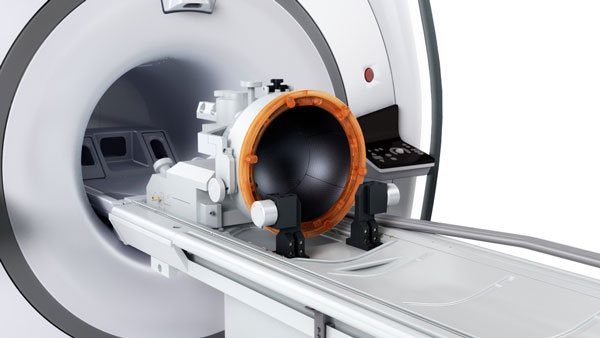An executive details the applications of MR-guided focused ultrasound, a developing technology for noninvasive surgery.
April 6, 2017

An executive details the applications of MR-guided focused ultrasound, a developing technology for noninvasive surgery.
Maurice R. Ferré, MD

Insightec's Exablate Neuro is used for focused ultrasound treatment.
Advancements in imaging technology over the past 30 years have enabled physicians to see what is happening inside a patient and make accurate diagnoses. The logical next step is to use this technology to facilitate actual treatments, which is becoming a reality as noninvasive surgery gains traction. Today, we find ourselves on the precipice of a major shift in the way physicians approach patient treatment and care.
MR-Guided Focused Ultrasound (MRgFUS): The Next Iteration of Ultrasound Technology
Ultrasound waves have been safely used in diagnostic imaging since the 1950s, and is most commonly known for being able to provide images of developing fetuses. However, this technology is now being utilized in a number of surgical applications.
By focusing ultrasound waves on a target area, tissue is heated and ablated non-invasively, while adjacent healthy tissue remains largely unharmed. During the procedure, MRI is used to plan the treatment, identify the target area, and monitor the procedure in real-time. This method has been proven both safe and effective, and can often be completed in a single treatment. The risk of infection is reduced or completely eradicated, and hospitalization is minimized or avoided altogether.
FDA-Approved Devices
The MR-guided focused ultrasound devices currently approved by FDA are used to treat essential tremor, uterine fibroids, and pain palliation of bone metastases. Replacing the invasive procedures typically utilized to treat these ailments can significantly improve overall patient quality of life and provide options to patients who may be apprehensive about going "under the knife"--offering a "no cuts" solution to doctors treating these individuals.
Essential tremor is a neurological condition affecting an estimated 10 million Americans, causing the uncontrollable shaking of hands, voice and other parts of the body. Typically, prescription medication is first used to treat the condition, but many see little to no improvement in their symptoms and can experience serious side effects. Some patients consider thalamotomy and deep brain stimulation (DBS), which requires placing electrodes into the brain and a pacemaker-like device into the chest. With focused ultrasound, neurosurgeons can noninvasively target and ablate the area of the brain responsible for the tremor. The treatment lasts around 3-4 hours, results in improved tremor, and patients usually return home the next day.
Focused ultrasound is also being utilized to treat uterine fibroids, which are noncancerous growths in the uterus that can cause pain, bleeding, and other symptoms. Many patients opt for "watchful waiting," which results in continued growth of the fibroids. Standard treatment is typically a hysterectomy, which is an invasive surgery that removes the uterus, leaving a woman unable to bear children and can result in hormonal imbalances. When treating with focused ultrasound, the uterus is spared; there are no scars, patients recovery quickly, and child bearing can be an option down the line.
Lastly, the treatment is also being used for pain palliation to improve metastatic bone cancer patients' quality of life. When cancer cells from a primary tumor spread to the bone the resulting severe pain significantly impairs daily living. Previously, the two main options to alleviate this pain were opioids and radiation therapy. For patients already undergoing a myriad of treatments and tests, focused ultrasound treatment provides pain relief within days.
Focused ultrasound provides noninvasive options to patients suffering from all three conditions, but it doesn't end there. This technology is in clinical trials to treat a number of other conditions that previously could only be treated with invasive surgeries or strong medications.
Looking Ahead: The Impact of MRgFUS on Patients and Physicians
MR-guided focused ultrasound devices have been adopted and are being used by physicians in more than 80 leading medical facilities in the United States and around the world, including Stanford University Medical Center, Brigham and Women's Hospital, and Weill Cornell Medical College, to name a few.
As this technology becomes widely available, it presents the opportunity for doctors to provide noninvasive treatments to patients who thought their options were limited. When provided a choice, most patients will opt for a noninvasive treatment if they know the option is available.
As the potential to change patients' lives becomes increasingly within reach, physicians are beginning to look at surgical procedures and patient care in a new light. MR-guided focused ultrasound provides a treatment that meets the needs of surgeons and patients alike--minimized risk of infection, reduced time in the hospital, and a rapid return to a symptom-free life.
Maurice R. Ferré, MD is INSIGHTEC'S CEO and Chairman of the Board of Directors. Dr. Ferré brings over 20 years of experience in the medical device industry to INSIGHTEC.
[Image courtesy of INSIGHTEC]
You May Also Like


